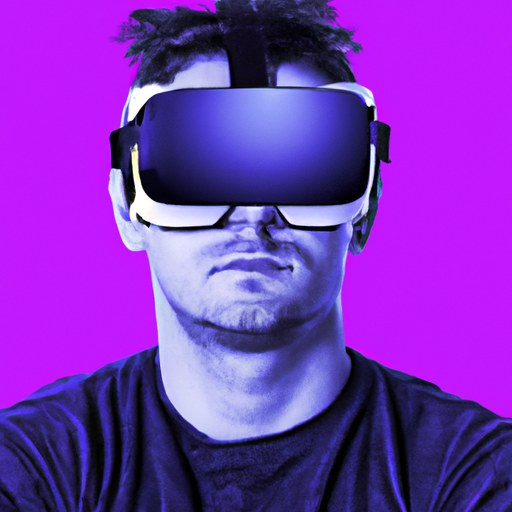What Is The Difference Between AR And VR Gaming? 8 Distinct Differences
What Is The Difference Between AR And VR Gaming: Introduction
In the world of gaming, there are two intriguing technologies that have been gaining popularity: Augmented Reality (AR) and Virtual Reality (VR). Both AR and VR gaming aim to provide immersive experiences, but they do so in distinct ways. So what is the difference between AR and VR gaming? AR gaming incorporates digital elements into the real world, enhancing your surroundings with virtual objects and characters. On the other hand, VR gaming transports you entirely into a computer-generated environment, allowing you to interact with a virtual world. While AR adds virtual elements to reality, VR completely immerses you in a virtual realm. Let’s explore further to unravel the fascinating differences between AR and VR gaming!

What Is The Difference Between AR And VR Gaming: Definition of AR Gaming
Explanation of the term AR
Augmented Reality (AR) is a technology that overlays digital information and virtual objects onto the real world. It bridges the gap between the virtual and physical realms, enhancing the user’s perception and interaction with the environment. By using a combination of cameras, sensors, and advanced computer graphics, AR blends the virtual and real worlds seamlessly, allowing users to experience digital content in a real-world context.
Introduction to AR gaming
AR gaming refers to the use of augmented reality technology in video games. It takes gaming experiences to a whole new level by integrating virtual objects and gameplay elements into the players’ real-world surroundings. Unlike traditional video games that are confined to screens, AR games immerse players in a personalized and interactive virtual world that interacts with their physical environment. This technology enables gamers to physically move around and interact with virtual objects, creating a unique and immersive gaming experience.
Characteristics of AR gaming
AR gaming offers several distinctive characteristics that set it apart from other gaming experiences. Firstly, AR games utilize the gamer’s actual environment as a crucial component of the gameplay, adding depth and realism to the virtual world. Secondly, AR games often involve real-time interactions with virtual objects, encouraging physical movement and interaction. Additionally, AR gaming often employs elements of location-based services, where players can explore and discover virtual content based on their real-world locations. This aspect adds an exciting and dynamic element to the gaming experience.
Definition of VR Gaming
Explanation of the term VR
Virtual Reality (VR) refers to a computer-generated simulation or artificial environment that can be interacted with and explored by the user. It immerses the user in a fully digital environment, shutting out the outside world and creating a sense of presence within the virtual realm. VR technology typically includes a head-mounted display (HMD), tracking sensors, and controllers to enable the user to interact with and navigate the virtual world.
Introduction to VR gaming
VR gaming entails playing video games within a virtual reality environment. It aims to provide users with a sense of complete immersion and presence in a digital world. By donning a VR headset, users are transported to an entirely different reality, where they can interact with the virtual environment and experience gameplay from a first-person perspective. VR gaming allows for a more intense and immersive gaming experience, as players feel like they are physically present within the game world.
Characteristics of VR gaming
VR gaming offers a range of unique characteristics that distinguish it from traditional gaming experiences. Firstly, the sense of immersion in virtual reality is unparalleled, allowing players to feel present and engaged in the game world. Additionally, VR gaming enables players to interact with virtual objects and characters using hand gestures and motions, enhancing the level of control and interactivity. Furthermore, VR games often incorporate spatial audio, 3D visuals, and realistic physics, further enhancing the sense of realism and immersion.
What Is The Difference Between AR And VR Gaming: Technologies Used
AR Technology
AR technology relies on a combination of hardware and software components to create augmented reality experiences. The hardware includes devices such as smartphones, tablets, smart glasses, and headsets equipped with cameras, motion sensors, and GPS modules to capture real-world data. Software algorithms process this data and overlay virtual objects onto the user’s field of view, creating the augmented reality experience.
VR Technology
VR technology encompasses specialized hardware and software designed to deliver virtual reality experiences. The key hardware component is the VR headset, which consists of a head-mounted display, headphones, and motion tracking sensors. These devices work together to track the user’s movements and adjust the visuals and audio accordingly. The software side involves creating realistic and interactive virtual environments that respond to the user’s actions and provide a seamless and immersive experience.
Comparison of technologies
While AR and VR both utilize advanced technologies to enhance gaming experiences, they differ in fundamental ways. AR integrates virtual content with the real world, while VR creates entirely digital environments. AR relies on real-time data from the user’s surroundings, whereas VR is self-contained and isolated from the real world. In terms of hardware, AR often utilizes everyday devices such as smartphones and tablets, while VR requires specialized headsets. The choice between AR and VR depends on the desired level of immersion, interactivity, and integration with the physical environment.
What Is The Difference Between AR And VR Gaming: User Experience
Interaction with the Real World in AR
AR gaming allows users to interact with the real world while simultaneously engaging with virtual elements. Players can see their immediate surroundings and use physical movements to interact with virtual objects. The integration of the real world enhances the sense of realism and enables players to strategize and devise gameplay tactics based on their physical surroundings. This unique blend of the virtual and physical realms creates a highly engaging and dynamic user experience.
Immersive Experience in VR
VR gaming offers a truly immersive experience by transporting users to virtual worlds that are visually and audibly rich. With VR headsets on, players are fully surrounded by the digital environment, shutting out distractions from the real world. They can explore vast virtual landscapes, engage in thrilling adventures, and interact with virtual objects in a way that feels incredibly real. The level of immersion in VR gaming is unparalleled, making players feel as if they have truly entered another reality.
Advantages and disadvantages of each user experience
The advantages of AR gaming lie in its ability to blend the virtual with the real, creating a unique and interactive experience. It encourages physical movement, fosters social interaction, and allows for personalized gameplay based on individual surroundings. On the other hand, VR gaming offers a more immersive and intense experience that transports players to entirely new worlds. It provides an escape from reality and allows for deep exploration and interaction with virtual environments and objects. However, VR gaming may also be isolating and limit physical movement. It requires dedicated hardware and can be more physically demanding than AR gaming.

What Is The Difference Between AR And VR Gaming: Hardware Requirements
AR Gaming Devices
AR gaming devices encompass a wide range of hardware, from smartphones and tablets to specialized smart glasses and headsets. For smartphone-based AR, users typically need a smartphone or tablet equipped with a camera, motion sensors, and an AR software platform. Smart glasses, such as Microsoft HoloLens or Google Glass, offer a hands-free AR experience, while AR headsets like the Oculus Quest 2 combine virtual reality and augmented reality capabilities. The hardware requirements for AR gaming vary depending on the desired level of immersion and functionality.
VR Gaming Devices
VR gaming devices primarily consist of VR headsets that provide visual and auditory immersion. These headsets, such as the Oculus Rift S, HTC Vive, or PlayStation VR, require a powerful gaming PC or gaming console to run the virtual reality software smoothly. The VR headset must be compatible with the gaming platform, and additional accessories like motion controllers and tracking sensors may also be necessary for a complete VR gaming experience. The hardware requirements for VR gaming are typically more demanding than those for AR gaming.
Cost and accessibility of hardware
The cost and accessibility of AR and VR gaming hardware vary depending on the specific devices and technologies involved. Smartphone-based AR gaming is often the most accessible and affordable option since many people already own compatible smartphones or tablets. Specialized AR glasses and headsets, as well as VR headsets, tend to be more expensive and may require additional hardware. However, the continued advancement of technology and increased market competition have led to more affordable options becoming available, making AR and VR gaming more accessible to a wider audience.
What Is The Difference Between AR And VR Gaming: Gameplay Mechanics
AR Gameplay Mechanics
AR gameplay mechanics focus on integrating virtual content with the real world and allowing users to interact with virtual objects and characters within their physical environment. Players can use touch gestures, voice commands, or handheld controllers to manipulate and control virtual elements. AR games often incorporate location-based features, where players must explore real-world locations to discover and interact with virtual content. These unique gameplay mechanics encourage physical movement, exploration, and strategic thinking based on the player’s surroundings.
VR Gameplay Mechanics
VR gameplay mechanics revolve around the user’s immersion and interaction within the virtual world. Players can physically move around and interact with virtual objects and characters using hand gestures, body movements, and specialized controllers. VR games often employ techniques like teleportation or smooth locomotion to enable players to navigate the virtual environment smoothly. The gameplay mechanics in VR focus on creating a fully interactive and immersive experience, where players can engage with the virtual world in a highly realistic and intuitive manner.
Comparison of gameplay mechanics
AR and VR gameplay mechanics differ in their approach to interaction and immersion. AR games leverage the real-world environment as an essential element of gameplay, incorporating real-time data and physical movement. VR gaming, on the other hand, immerses players entirely in the virtual world, offering more control and interactivity within the digital realm. While both types of gameplay mechanics have their unique advantages and appeal, the choice between AR and VR largely depends on the desired level of immersion, physical interaction, and integration with the real world.

Popular Games and Applications
Examples of AR games
AR games have gained significant popularity across various platforms. Pokémon Go, one of the most well-known AR games, introduced millions of players to the world of augmented reality by allowing them to catch virtual Pokémon in their real-world surroundings. Another popular AR game is Minecraft Earth, a mobile game that lets players build and explore virtual structures in their actual environment. Additionally, Ingress and Harry Potter: Wizards Unite are notable examples of AR games that encourage players to explore real-world locations while engaging in immersive gameplay.
Examples of VR games
VR gaming has also witnessed the release of numerous captivating games that leverage the immersive capabilities of virtual reality. Some noteworthy VR games include Beat Saber, a rhythm-based game that challenges players to slash through music beats with virtual lightsabers, and Superhot VR, a first-person shooter that combines intense action and strategic gameplay. Other popular VR games like Robo Recall, Half-Life: Alyx, and Job Simulator showcase the diverse genres and experiences available within the realm of virtual reality gaming.
Applications beyond gaming
While gaming is a prominent application of AR and VR technologies, both have proven potential beyond the gaming industry. AR has been utilized in fields such as architecture and interior design, allowing professionals to visualize and present virtual models of buildings and spaces in the real world. In education, AR has been used to create interactive learning experiences, where students can explore and manipulate virtual content alongside their physical surroundings. VR has found applications in training simulations, therapy, and virtual tourism, providing realistic and immersive experiences in various contexts.
Social and Multiplayer Aspects
AR Social and Multiplayer Features
AR gaming presents unique opportunities for social and multiplayer experiences. Multiplayer AR games allow friends or strangers to interact and collaborate within the same augmented reality environment. Players can join forces to battle virtual enemies, complete quests, or explore virtual territory together. AR also enables social interactions by overlaying user-generated content, such as messages and avatars, onto the real world. This blending of virtual and physical realms allows for shared experiences and social engagement in a unique and personalized manner.
VR Social and Multiplayer Features
VR gaming offers a highly immersive and social experience through multiplayer VR games and social VR platforms. Multiplayer VR games enable players to interact and communicate with each other inside virtual worlds, fostering teamwork, competition, and socializing. Social VR platforms provide virtual spaces where users can meet, chat, and engage in various activities together, bridging the physical distance between individuals. VR social experiences allow for realistic avatars, voice communication, and shared virtual environments, creating a sense of presence and connection.
Comparison of social and multiplayer aspects
The social and multiplayer aspects of AR and VR gaming cater to different preferences and experiences. AR social and multiplayer features incorporate the real world into interactions, offering a shared experience in familiar surroundings. In contrast, VR social and multiplayer features immerse users in virtual environments, enabling interactions and connections in entirely digital realms. Both approaches provide unique opportunities for socialization and collaboration, with AR focusing on blending virtual content with reality and VR emphasizing shared presence and immersive experiences.

Market Trends and Adoption
AR Gaming Market
The AR gaming market has seen steady growth in recent years, driven by advancements in mobile devices and increased consumer awareness about AR technology. The popularity of AR games like Pokémon Go has demonstrated the mainstream appeal and potential of this technology. The market is expected to further expand as more smartphones, tablets, and wearable AR devices enter the market. Additionally, the integration of AR features in social media platforms and e-commerce applications has contributed to the growing popularity and adoption of AR gaming.
VR Gaming Market
The VR gaming market has also witnessed significant growth, although it may not have reached the same level of mainstream adoption as AR gaming. The availability of high-quality VR headsets and a growing library of immersive games has contributed to the increasing demand for VR gaming experiences. The market’s growth is further fueled by the emergence of standalone VR systems, such as the Oculus Quest series, which provide untethered and accessible VR experiences. As the technology continues to advance and become more affordable, the VR gaming market is expected to expand further.
Factors influencing market adoption
Several factors influence the adoption and growth of AR and VR gaming. Technological advancements, such as improved graphics, higher display resolutions, and more accurate tracking systems, play a crucial role in enhancing the gaming experience and attracting consumers. Additionally, the availability and affordability of hardware and software, as well as ease of use, influence the adoption rate. User acceptance and awareness, driven by popular games and applications, also contribute to market growth. Furthermore, the integration of AR and VR into other industries, such as education, healthcare, and entertainment, expands the potential user base and accelerates adoption.
What Is The Difference Between AR And VR Gaming: Future of AR and VR Gaming
Technological advancements
The future of AR and VR gaming holds tremendous potential for technological advancements. Continued improvements in display technologies, such as higher resolutions and wider fields of view, will enhance the visual quality and immersion of AR and VR experiences. Advancements in tracking systems will enable more precise and intuitive interactions with virtual content. Furthermore, the development of haptic feedback technology and realistic simulation of physical sensations will further immerse users in the virtual worlds of gaming.
Integration of AR and VR
The integration of AR and VR technologies is expected to accelerate, blending the strengths of both to create even more compelling gaming experiences. Hybrid devices that offer both AR and VR capabilities may become more common, enabling users to seamlessly switch between the two modes as desired. This integration will allow for enhanced immersion and interaction while still leveraging the user’s physical environment. The combination of AR and VR has the potential to revolutionize gaming by providing dynamic and personalized experiences tailored to individual preferences.
Potential applications and innovations
Beyond gaming, AR and VR technologies hold immense potential for various industries. In education, AR and VR can enhance learning experiences by providing interactive and immersive educational content. Medical professionals can benefit from VR simulations for training and surgical procedures, while AR can assist in medical diagnosis and treatment. The entertainment and media industries can explore new forms of storytelling and immersive experiences using both AR and VR. Furthermore, these technologies can play a significant role in architecture, urban planning, and manufacturing, enabling visualization and design in virtual environments.
What Is The Difference Between AR And VR Gaming: In A Nutshell
In conclusion, AR and VR gaming offer unique and immersive experiences that push the boundaries of traditional gaming. AR enriches the real world with virtual elements, fostering personalized and interactive gameplay. VR, on the other hand, transports users to entirely digital worlds, providing intense immersion and control within virtual environments. Both technologies have their advantages and applications, and the choice between AR and VR gaming depends on personal preferences and desired experiences. With ongoing technological advancements and increasing market adoption, the future of AR and VR gaming holds immense potential for innovation and growth across various industries.




